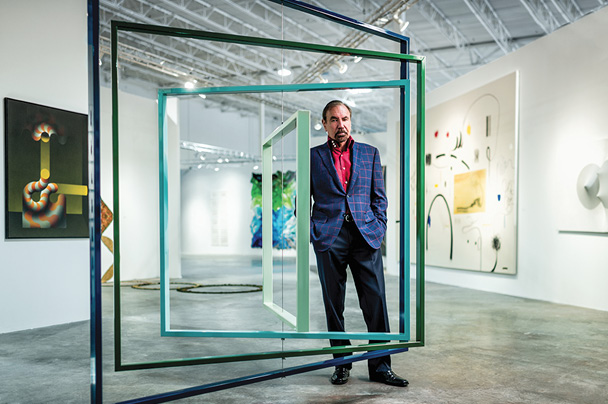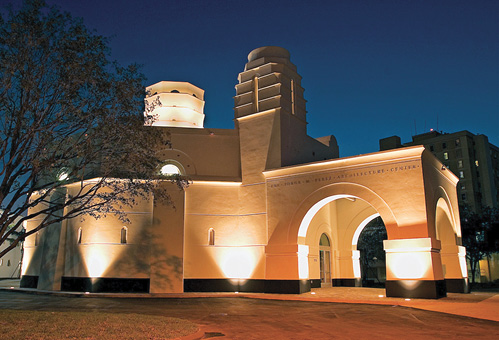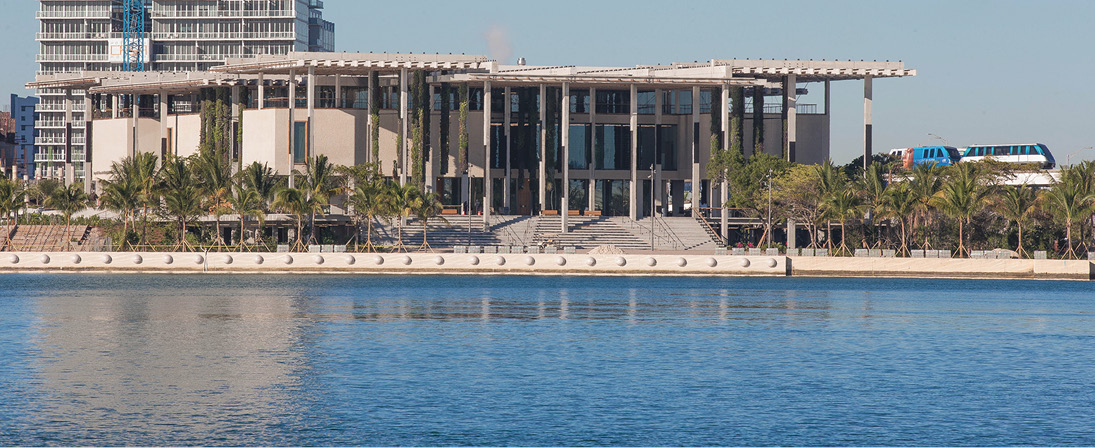- Home
- Media Kit
- Current Issue
- Past Issues
- Ad Specs-Submission
- Ad Print Settings
- Reprints (PDF)
- Photo Specifications (PDF)
- Contact Us

![]()
ONLINE


Jorge M. Pérez at the Pérez Art Museum
A Lasting Impact
Editors’ Note
Jorge Pérez has been at the forefront of South Florida’s urban evolution for some time, often being the first developer to enter emerging or undiscovered neighborhoods. Pérez began his career in the late 1970s, building in neighborhoods such as Miami’s Little Havana and Homestead. He currently chairs the Miami-Dade Cultural Affairs Council and is a director of the Miami International Film Festival. He is also a member of the University of Miami’s Board of Trustees. In 2013, Pérez was honored with South Florida Business Journal’s Lifetime Achievement Award. The Miami Art Museum was named The Pérez Art Museum Miami after his $40-million lead gift. Additionally, the University of Miami Architecture Center is named after him. He was also named among the 25 Most Influential Hispanics in the U.S by TIME magazine. He graduated summa cum laude from C.W. Post College and earned a Masters Degree in Urban Planning, with highest honors, from the University of Michigan.
Company Brief
Since its inception in 1979, The Related Group (relatedgroup.com), a privately held company, has built and managed more than 90,000 condominium and apartment residences in major markets throughout Florida. Today, more than 500 people throughout South Florida are employed by the firm. In addition to its core base of business, the company operates its own real estate financing, sales, and property management subsidiaries. The group is broadening its reach to other markets in the U.S., Latin America, and abroad.
When you look at the effort you have put into philanthropy, while you have tremendous business pressure and your time is pulled in many directions, philanthropy is such a core part of who you are. Would you talk about where that desire to give back came from?
It came about when I was growing up in South America. My parents were always very socially conscious. They had lost all of their money and, due to the Cuban Revolution, had to leave for Colombia. Even after losing their money, they were always very aware that societies could not function when some people were very wealthy and some people were very poor and didn’t have access to many of the things that make life worth living.

The Jorge M. Pérez Architecture Center
at the University of Miami
I was raised to see not only the poverty but the poverty next to real wealth. That was always a shock to me. When I came to this country, that is why I wanted to study economics, but not business economics – I wanted to try to do something that would better society.
From high school onward, I always had that desire to help equalize. I always felt that I needed to help create the systems that would allow people with lesser means and less opportunity to achieve better positions in life.
That was with me all throughout my university studies and along my career. When I started in business, which I didn’t think I was going to do, I went from the public sector and doing good things for poor neighborhoods to building affordable housing. My first few years were focused on housing for the poor, which felt very good – in a way it was philanthropy. We were accomplishing good deeds for society and it was always there and stayed with me.
I do it to help solve an injustice and also because it makes me feel good that I’m not just sitting and looking at the ills of the world without doing something about them.
You are known to be results-oriented. With so much need out there, was it important as your philanthropy evolved to hone in on specific areas where you could make the most impact? How are you effective when it comes to philanthropy?
There are a series of parameters we look at. The multiplier effect of money is very important. It’s much better to give when one dollar given produces $10. Sometimes that is easy to measure and sometimes it’s difficult.
To me, because I have an affinity for the arts and I’ve been involved with them for so long as a member of the National Endowment for the Arts, I feel that while economics feeds the stomach, the arts feed the soul. Every study has also shown that children that have been exposed to an art education have expanded minds that allow them to perform much better, not just scholastically but generally in life.

The Pérez Art Museum Miami
That is one of the reasons I felt it was so important to get involved with the arts.
Also, because there are so many needs and because my wife is in the medical field, we have worked with Florida International University and their School of Nursing, particularly to help the students, many who are not wealthy, gain an education. We made a cancer research grant for MASS General, as advancements in cancer treatment have always been important to us. We have also done a Pérez patient care center for cancer patients and their families in Miami.
My focus tends to be on art and design, so we funded the University of Michigan and the School of Architecture at the University of Miami – those were important to me.
We provide scholarships for students to go into those fields and have the same opportunities that other kids with more money have.
As we give, it’s important to be involved in giving as opposed to writing a check to which we have no connection.
Whenever we give money, we ask people to write something telling us what they are going to do with this money and if there will be waste in the expenditure. We want to know what impact that dollar is going to have and how it will benefit those in need and its multiple effects.
Many say there is a learning curve on effective philanthropy. Did you catch on to that quickly?
There’s a huge learning curve, particularly when one gives with the heart. In business, it’s always about risk-to-return ratios. Many times when we start getting involved with philanthropy, we give without understanding what measures will determine if something good is being done and how many will be affected.
It’s important to measure how we give and treat it like a business investment in order to make sure our money has the greatest impact.
My wife and I try to attend as many meetings and seminars as we can that concern giving. It comes down to who we’re giving to and how good we feel about how they will spend our money. It requires a lot of interviews and follow up to make sure they are doing what they said they will do. I like to give over time and have it based on performance. Unfortunately, there is so little money available and so many needs.
I tend to stay away from people who request a certain amount of money for something that isn’t personal for me. I give where there is a meaningful result.
You are strong on the benefits of the arts, especially bringing art to young people early in their lives to get them interested. With the many cuts in this area today, how critical is it that focus on the arts be maintained for young people and is the dialogue there to encourage it?
When people ask why we give to the arts when people are starving or dying from disease, it’s because in times of need, the arts get cut financially in the worst way. When the economy crashes, art giving declines at a much higher level than other types of philanthropy.
We currently have all third-graders from public schools going to the museum for free. When they go to class and have their imaginations awakened by asking questions, and have those moments that might not ever come in their daily lives because of the problems they’re dealing with, it becomes clear that this is a very important part of their growth.
For a city like Miami that never had a museum, this is very important because these students can’t go to MoMA or the Met. Putting up a museum allows people that would otherwise never be exposed to the arts the opportunity to enjoy them, particularly children but also the elderly that don’t have the means to look at great art. In addition, there are no great cities without great museums, so developing that in Miami was very important. I feel strongly that Miami will become one of the greatest cities in the world. For that to happen, it must have the cultural facilities to compete with Paris, London, and New York.
The same thing happened with universities and colleges. We gave because it allows students in this city to get a better education but just as importantly, there are not great cities without great educational institutions, both public and private.
It’s about making sure that Miami and all of its institutions become great and serve its population well, particularly one that isn’t as wealthy.
When you look at the museum and what it has become, is it what you had envisioned and was there a lot of adapting as it got off the ground?
We’ve actually met and exceeded all of our expectations as to both our attendance and our ability to help lower-income children and the elderly.
Every public institution has financial issues – none of them survive with public giving alone. There needs to be a great deal of private fundraising in order for institutions to survive and thrive.
We have met the goals, and every year we continue to give substantial amounts of art. We continue to fund the development department and we continue to fund exhibitions. We just opened an African-American fund, and my wife is opening a fund for women artists.
We continue to make sure the institution is capable of reaching its goals. It’s not only about giving of money but also asking. I have to fundraise from my friends, I have to go to the government and beg them not to reduce our subsidies. It’s a continual process.
It’s what I expected in that it is a continuing involvement with the institution and that the institution has served the purpose of both achieving and reaching its audience.
Do you feel that those efforts will have to be driven by the private sector to truly impact change and address challenges?
It’s different in every community. There is no question in my mind that for institutions to survive, a partnership between the public and private sector must exist. The private sector can’t do it on its own and the public sector can’t either.
Convincing both sides to work together is very important. By that I’m not just talking about fundraising, but about the managing of institutions. I think the private sector typically does a better job at managing these institutions. The well-run museums in the U.S. are generally managed by a private board that puts a lot of time into making sure that the institutions are managed in an efficient way, where fundraising becomes important.
When the public sector takes over, bureaucracy can be overwhelming and there are expenditures that might not be necessary, and fundraising becomes less important.
I also think the public sector should have members on the boards because they’re contributing money so they are fully vested and part of the decision-making process.
Public/private partnerships are the way to go.
Many talk about the type of buildings you’ve developed and their impact. However, you seem to get more fulfillment through your philanthropic efforts. Is that the case?
I am very fortunate in that I love what I do and to me, each one of these buildings I’m putting up is like a little sculpture. I really get a kick out of working with the best minds on not only the exteriors but also the interiors of these buildings. Seeing them come to fruition and seeing them completed is a real high. It’s a legacy. These buildings will become an integral part of Miami.
Both areas – business and philanthropy –make me very proud. I am very passionate about both. I’m proud of my employees and what they do. It’s a sense of personal accomplishment, having created a group of people that deliver great quality and make the city a better place to live.
When all is said and done, there is nothing like watching that one child experience the joy of going to the museum and learning; or when I look at the nursing students engaged in their courses and setting themselves up to help the world – those are lasting impressions.
I’m very lucky – both development and philanthropy are deeply felt. The money is very secondary in the business at this point.
Those who know you say it’s hard to imagine a time when you will slow down. Do you agree?
It’s not about slowing down but about redirecting. I don’t have the energy I used to have but I redirect. I’m very blessed to have great people that can handle the business so I can work on philanthropy, travel more, and read and do other things I had to give up as I was building the company.•